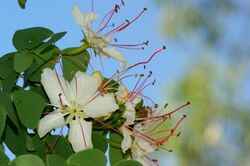Biology:Cercidoideae
| Cercidoideae | |
|---|---|

| |
| Cercis siliquastrum | |

| |
| Phanera variegata | |
| Scientific classification | |
| Kingdom: | Plantae |
| Clade: | Tracheophytes |
| Clade: | Angiosperms |
| Clade: | Eudicots |
| Clade: | Rosids |
| Order: | Fabales |
| Family: | Fabaceae |
| Subfamily: | Cercidoideae Legume Phylogeny Working Group[2] |
| Type genus | |
| Cercis L.
| |
| Genera | |
|
See text | |
| Synonyms | |
| |
Cercidoideae is a subfamily in the pea family, Fabaceae. Well-known members include Cercis (redbuds), including species widely cultivated as ornamental trees in the United States and Europe, Bauhinia, widely cultivated as an ornamental tree in tropical Asia, and Tylosema , a semi-woody genus of Africa. The subfamily occupies a basal position within the Fabaceae and is supported as monophyletic in many molecular phylogenies.[3][4][5][6][7][8] At the 6th International Legume Conference, the Legume Phylogeny Working Group proposed elevating the tribe Cercidae to the level of subfamily within the Leguminosae (Fabaceae).[9] The consensus agreed to the change, which was fully implemented in 2017.[2] It has the following clade-based definition:
The most inclusive crown clade containing Cercis canadensis L. and Bauhinia divaricata L. but not Poeppigia procera C.Presl, Duparquetia orchidacea Baill., or Bobgunnia fistuloides (Harms) J.H.Kirkbr. & Wiersema.[2]
Many genera show unique palynology.[10][11]
Genera
Cercidoideae comprises the following genera[2][12][13] organized into tribes:[14]
Cercideae
- Adenolobus (Harv. ex Benth. & Hook.f.) Torre & Hillc.
- Cercis L.
- Griffonia Baill.
Bauhinieae
- Barklya F. Muell.
- Bauhinia L.
- Brenierea Humbert
- Cheniella R.Clark & Mackinder[15]
- Gigasiphon Drake
- Lasiobema (Korth.) Miq.[Note 1]
- Lysiphyllum (Benth.) deWit
- Phanera Lour.[16]
- Piliostigma Hochst.
- Schnella Raddi
- Tournaya A.Schmitz[16]
- Tylosema (Schweinf.) Torre & Hillc.
Extinct
Phylogeny
Molecular phylogenetics suggest the following relationships:[12][14][15][18]
| Fabales |
| ||||||||||||||||||||||||||||||||||||||||||||||||||||||||||||||||||||||||||||||||||||
Notes
- ↑ Some sources treat Lasiobema as a section of genus Phanera.
References
- ↑ "Fabales". https://mobot.org/MOBOT/research/APweb/orders/fabalesweb.htm.
- ↑ 2.0 2.1 2.2 2.3 The Legume Phylogeny Working Group (LPWG). (2017). "A new subfamily classification of the Leguminosae based on a taxonomically comprehensive phylogeny". Taxon 66 (1): 44–77. doi:10.12705/661.3.
- ↑ "Towards a comprehensive phylogeny of legumes: Evidence from rbcL sequences and non-molecular data". Advances in Legume Systematics, Part 9. Kew, UK: Royal Botanic Gardens. 2000. pp. 1–20. ISBN 184246017X. http://www.kewbooks.com/asps/ShowDetails.asp?id=52.
- ↑ "Phylogenetic Relationships in the Caesalpinioideae (Leguminosae) as Inferred from Chloroplast trnL Intron Sequences". Syst Bot 26 (3): 487–514. 2001. doi:10.1043/0363-6445-26.3.487. http://www.bioone.org/doi/full/10.1043/0363-6445-26.3.487.
- ↑ "Phylogeny and Biogeography of Cercis (Fabaceae): Evidence from Nuclear Ribosomal ITS and Chloroplast ndhF Sequence Data". Syst Bot 27 (2): 289–302. 2002. doi:10.1043/0363-6445-27.2.289. http://www.bioone.org/doi/abs/10.1043/0363-6445-27.2.289.
- ↑ "A phylogeny of legumes (Leguminosae) based on analysis of the plastid matK gene resolves many well-supported subclades within the family". Am J Bot 91 (11): 1846–62. 2004. doi:10.3732/ajb.91.11.1846. PMID 21652332.
- ↑ "Phylogenetic patterns and diversification in the caesalpinioid legumes". Botany 86 (7): 697–718. 2008. doi:10.1139/b08-058.
- ↑ LPWG [Legume Phylogeny Working Group] (2013). "Legume phylogeny and classification in the 21st century: progress, prospects and lessons for other species-rich clades". Taxon 62 (2): 217–248. doi:10.12705/622.8. https://www.zora.uzh.ch/id/eprint/78167/1/Taxon_2013_217-248.pdf.
- ↑ LPWG [Legume Phylogeny Working Group] (2013). "Towards a new classification system for legumes: Progress report from the 6th International Legume Conference". S Afr J Bot 89: 3–9. doi:10.1016/j.sajb.2013.07.022.
- ↑ "Palynological contribution to the systematics and taxonomy of Bauhinia s.l. (Leguminosae: Cercideae)". South African Journal of Botany 89: 219–226. 2013. doi:10.1016/j.sajb.2013.07.028.
- ↑ "Evolution and diversity of pollen morphology in tribe Cercideae (Leguminosae)". Taxon 63 (2): 299–314. 2014. doi:10.12705/632.37.
- ↑ 12.0 12.1 "The genus Bauhinia s.l. (Leguminosae): A phylogeny based on the plastid trnL–trnF region". Botany 87 (10): 947–960. 2009. doi:10.1139/B09-065.
- ↑ Wunderlin RP (2010). "Reorganization of the Cercideae (Fabaceae: Caesalpinioideae)". Phytoneuron 48: 1–5. http://www.phytoneuron.net/PhytoN-Cercideae.pdf.
- ↑ 14.0 14.1 Wunderlin RP (2010). "Reorganization of the Cercideae (Fabaceae: Caesalpinioideae)". Phytoneuron 48: 1–5. http://www.phytoneuron.net/PhytoN-Cercideae.pdf.
- ↑ 15.0 15.1 "Cheniella gen. nov. (Leguminosae: Cercidoideae) from southern China, Indochina and Malesia". European Journal of Taxonomy (360): 1–37. 2017. doi:10.5852/ejt.2017.360.
- ↑ 16.0 16.1 Jiang, Kai-Wen (2020). "New Combinations in the Genus Phanera (Fabaceae: Cercidoideae) of China". J. Jpn. Bot. 95 (4): 211–213.
- ↑ "Bauhcis moranii gen. et sp. nov. (Cercideae, Caesalpinieae), an Oligocene plant from Tepexi de Rodríguez, Puebla, Mex., with leaf architecture similar to Bauhinia and Cercis". Rev Palaeobot Palynol 122 (3–4): 171–184. 2002. doi:10.1016/S0034-6667(02)00135-5.
- ↑ "Plastid Genome Evolution in the Early-Diverging Legume Subfamily Cercidoideae (Fabaceae)". Frontiers in Plant Science 138 (138): 1–12. 2018. doi:10.3389/fpls.2018.00138. PMID 29479365.
External links
Wikidata ☰ Q42398994 entry
 |



